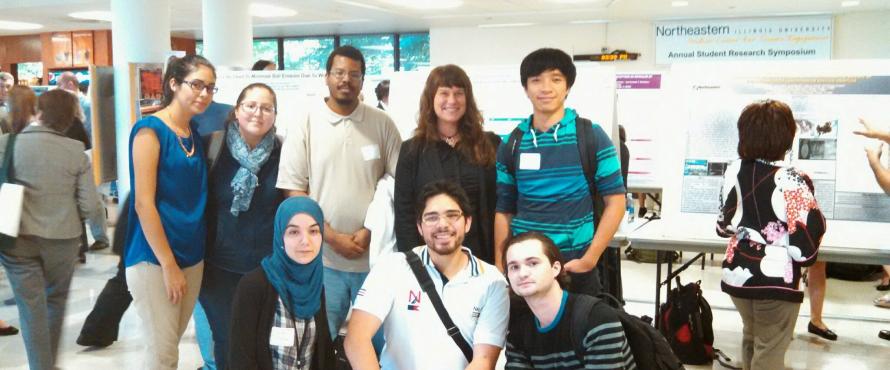With the September induction of seven junior-year students, Northeastern Illinois University officially became the second university in the Midwest to launch a National Institutes of Health MARC (Maximizing Access to Research Careers) grant program.
The five-year, $1.5 million grant is designed to support undergraduate students who are underrepresented in the biomedical and behavioral science fields to improve their preparation for training at the Ph.D. level. Michigan State University is the only other university in the region with a MARC program.
“I feel really good about starting this program,” said Northeastern psychology professor Breckie Church, who oversees the program along with biology associate professor Emina Stojković and College of Arts and Sciences Associate Dean David Rutschman. “I’ll feel even better when we have achieved our goal of getting all of our MARC scholars into Ph.D. programs.”
Starting with four students this year, the grant pays for 60 percent of tuition, an annual living stipend, a paid summer research experience and supports resources for individualized guidance through undergraduate degree completion through their junior and senior years.
In addition to the four students who will receive the financial benefits of the MARC grant, an additional three “pre-MARC scholars” were selected. They have access to all of the non-financial benefits of the program with the goal to get all of the students into Ph.D. graduate programs.
Here are the seven inaugural students in Northeastern’s MARC program.
MARC scholars
Wil Bogue
Bogue is a double major in biology and computer science with a minor in mathematical modeling. He has conducted research on complex prey recognition in praying mantises as well as elucidating physiological changes in the visual system of Madagascar hissing cockroaches. Bogue hopes to pursue an interdisciplinary research career combining neurology, computer science and mathematical modeling to better understand and develop technology that helps the lives of individuals with special needs.
Leslie Carrillo
Carrillo is a first-generation college student majoring in chemistry and biology. Her research interests include tissue development, craniofacial abnormalities and periconceptional folic acid supplementation in mice. Her goal is to apply to graduate programs in biomedical or chemical engineering to research the use of nanomaterials in drug therapies and artificial tissue.
Robert Fidis
Fidis is a double major in biology and chemistry with a minor in applied mathematics. His research includes looking at neurological tube defects such as Spina bifida and cleft palette as well as behavioral research with disorders such as ADHD and anxiety in mice due to different concentration levels of folic acid. He wishes to apply to graduate school to study in the biomedical or biochemical sciences.
Rima Rebiai
Rebiai is a biology and chemistry major with a minor in applied mathematics. She is currently collaborating on a study conducted by Ken Nicholson and Emina Stojkovic to characterize the domain structure of bacterial red-light photoreceptors that have been recently engineered for use as infrared fluorescent protein markers. Rebai intends to go into a graduate program where she can continue doing research.
Pre-MARC scholars
Giovanni Monterroso
Monterroso is a biology major with a dual minor in chemistry and applied mathematics. In the field of marine biology, he wants to focus on whales and dolphins, studying their behavior and the genetic differences between the different whale and dolphin pods. Also in the field of genetics, Monterroso wants to focus on the pathology of diabetes. He’d like to research exactly how it is passed on genetically and for those who get diabetes later in life, if there is a latent form similar to the shingles virus.
Justin Ramirez
Ramirez is a chemistry major and physics minor. He has conducted research in the area of materials science, working on the development of organic photovoltaics. Currently, he is involved in research centered around the imaging of cells and bacteria using atomic force microscopy. Upon completion of his B.S. degree, Ramirez aims to pursue his Ph.D. in materials science with a focus on nanotechnology.
Adriana Roman
Roman has a general interest in human health and how the environment affects our health. In particular, she is fascinated with how cells function and are dependent on the chemistry of the cellular environment. Roman’s pursuit of a Ph.D. in biomedical science and a carrer in research will be used to improve the lives of those less fortunate in her native country of Mexico.








